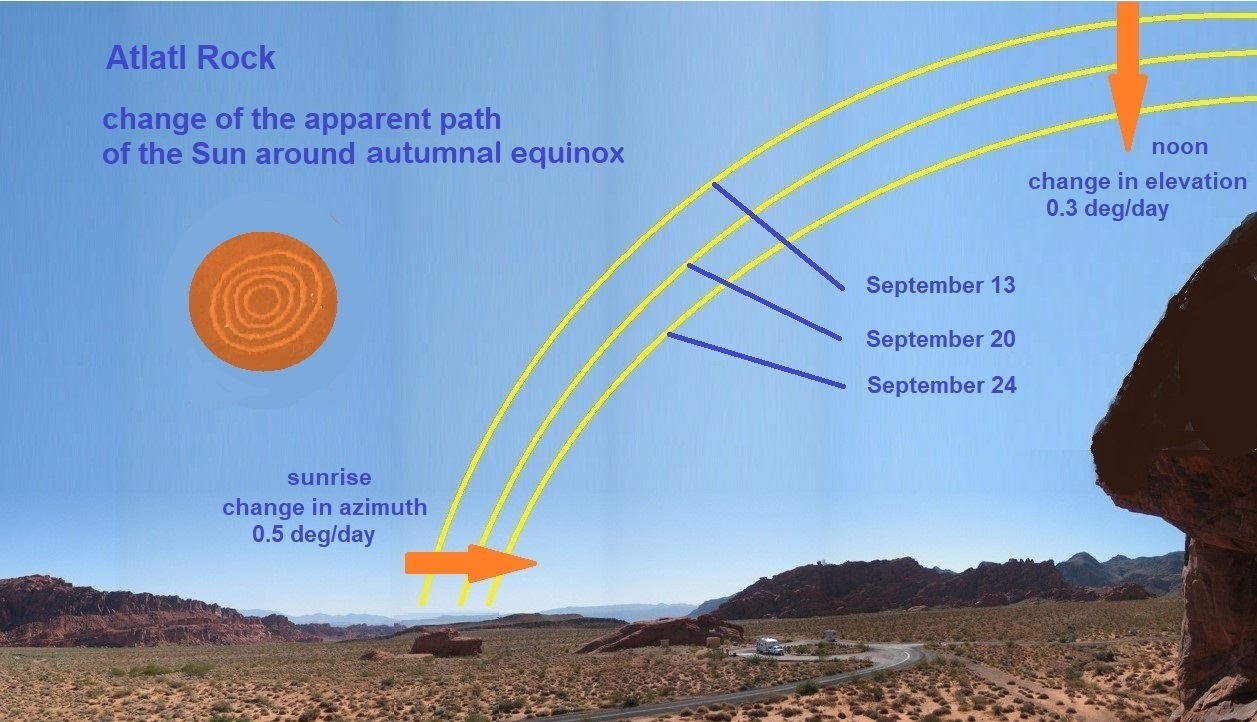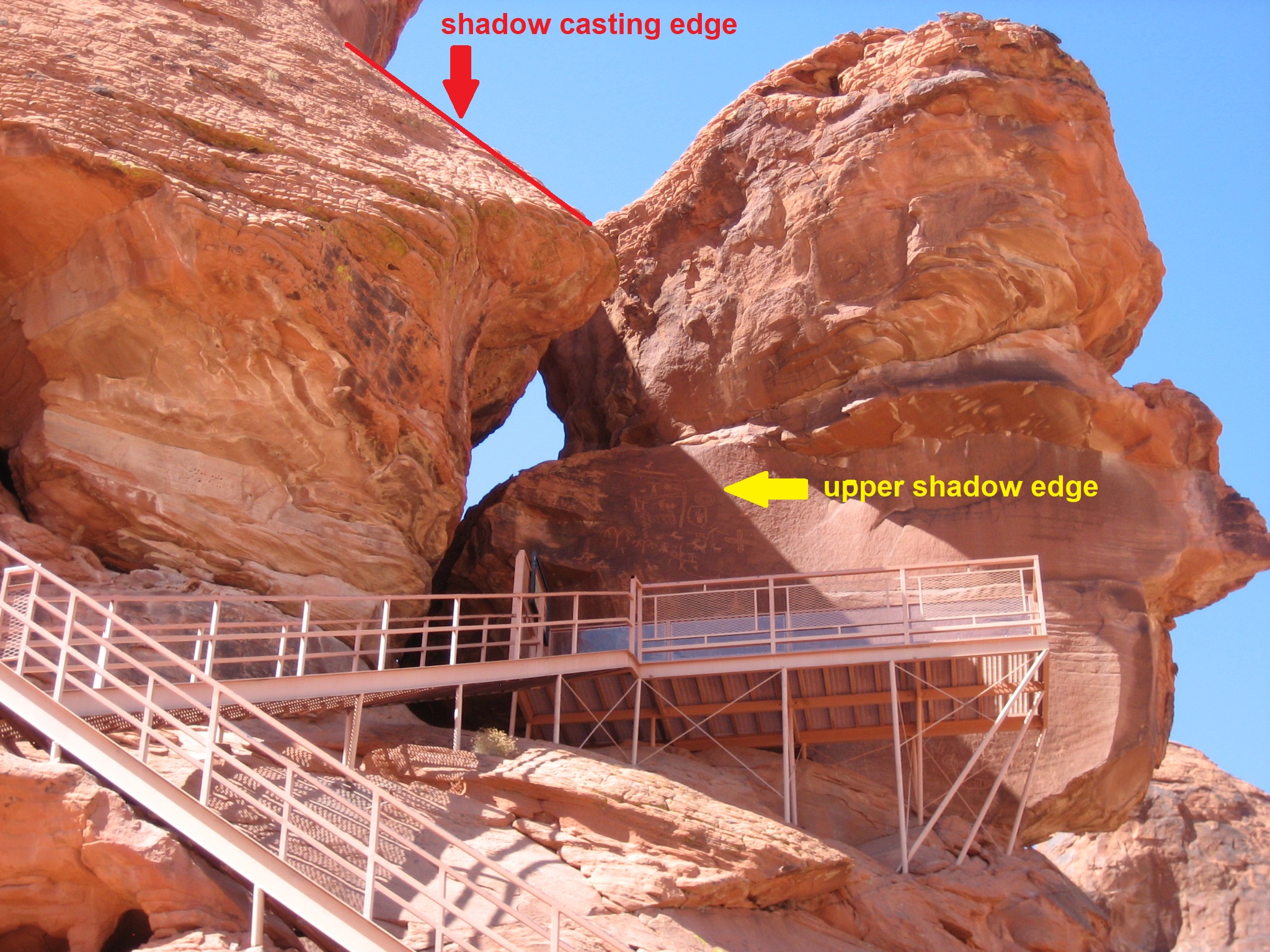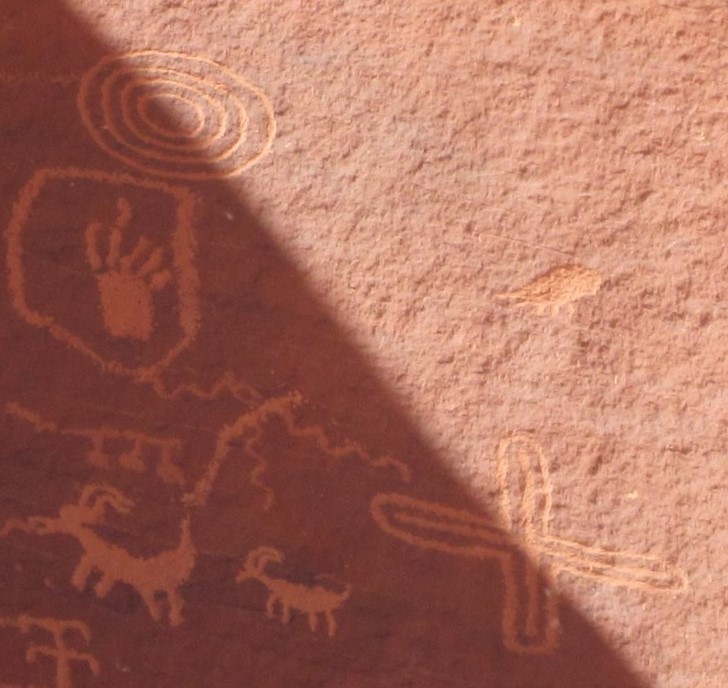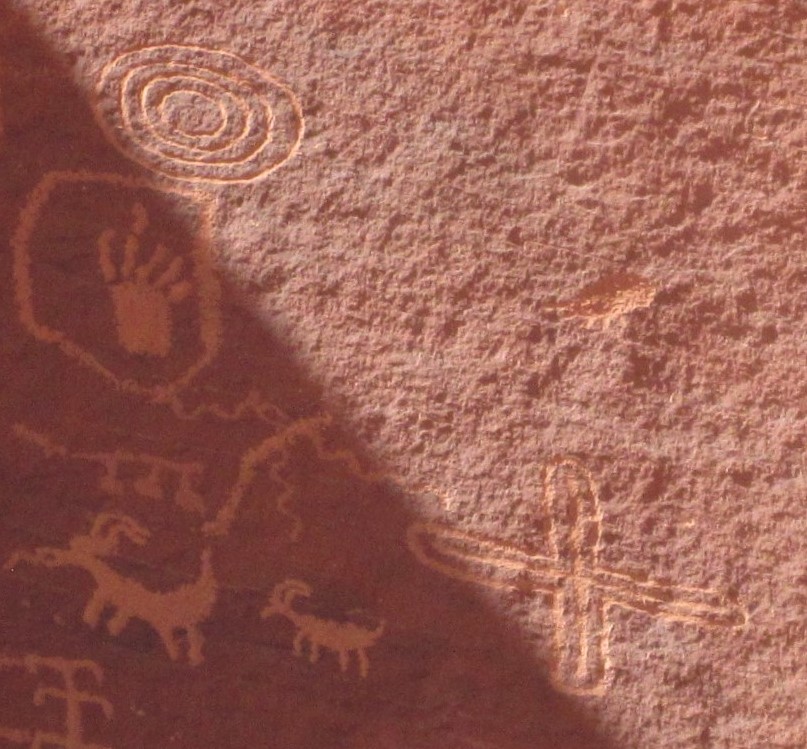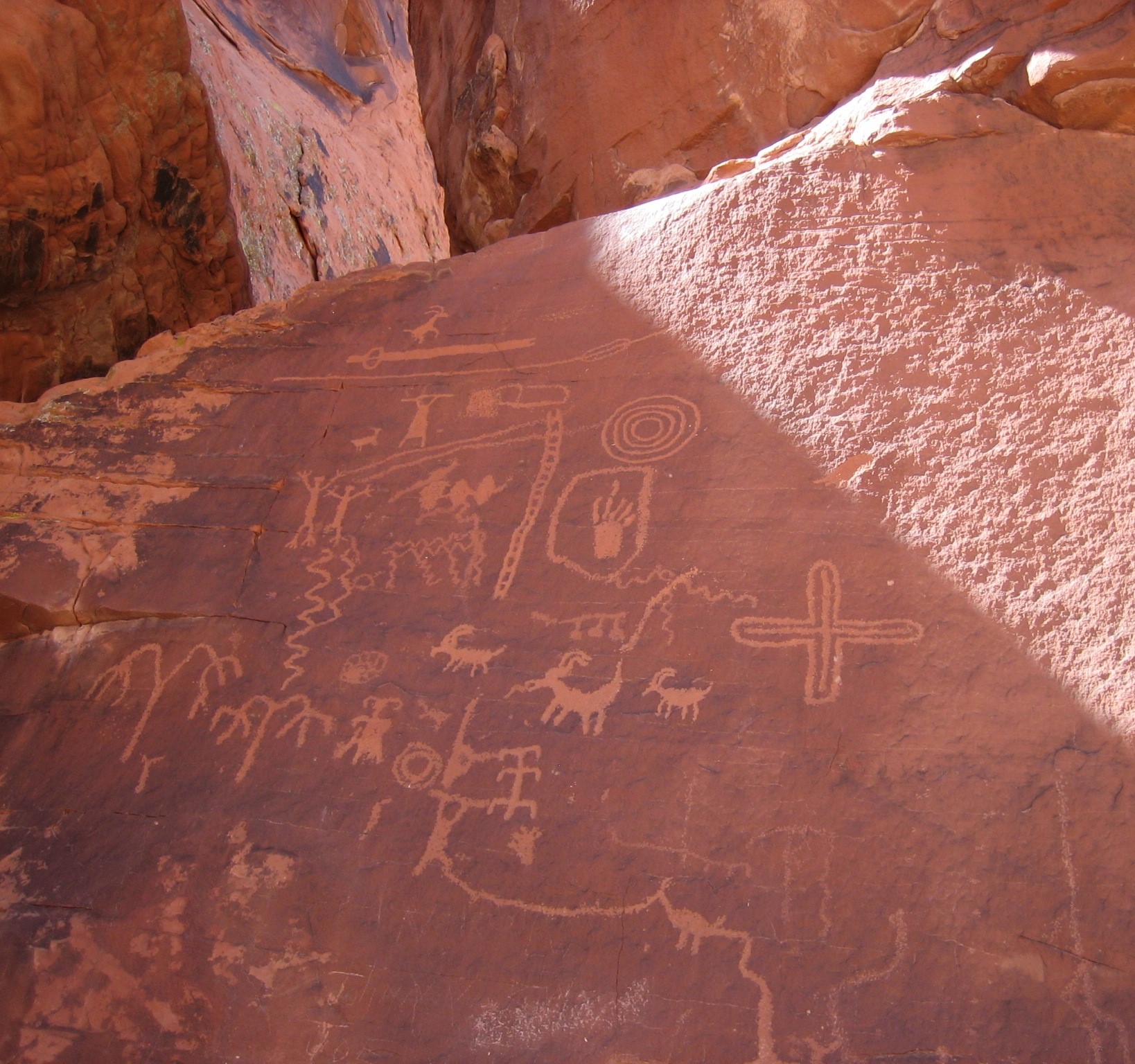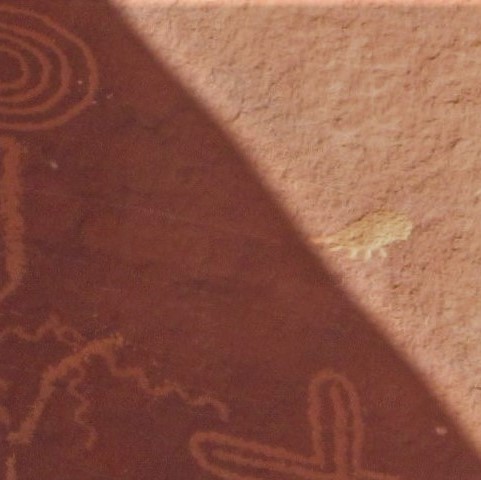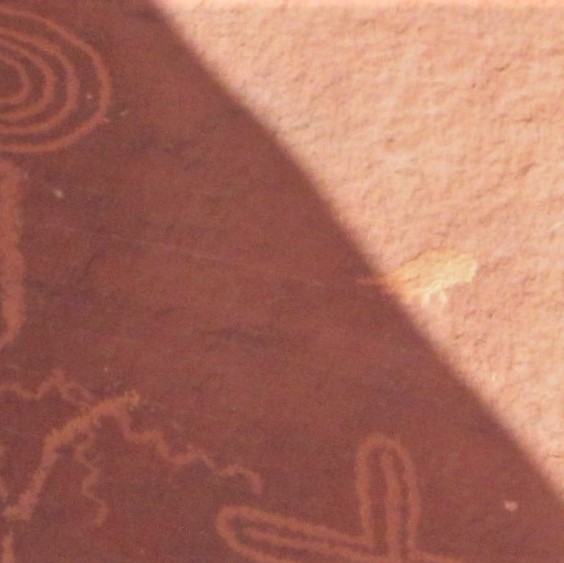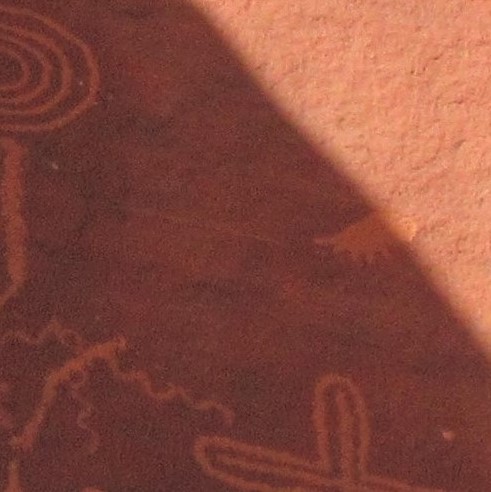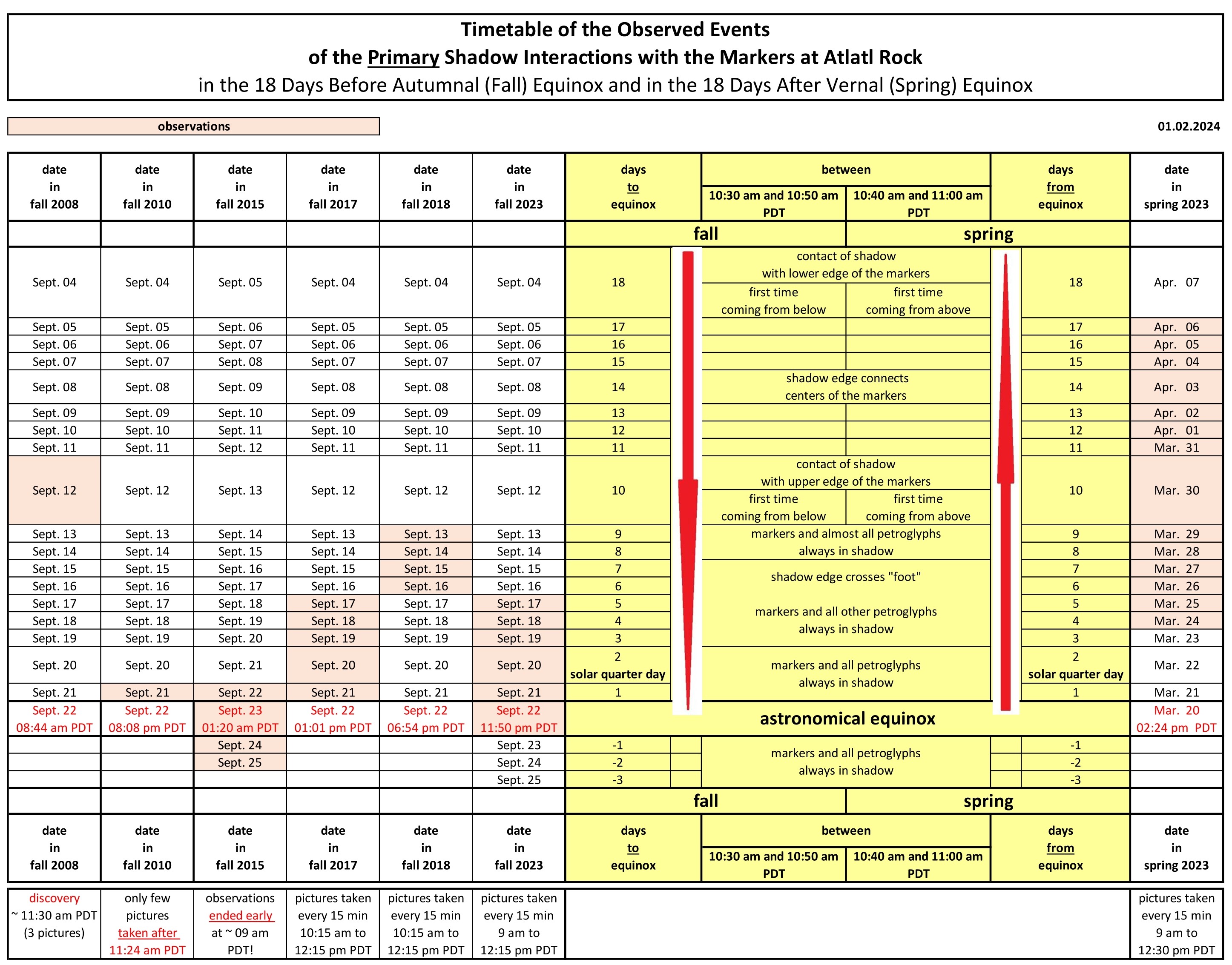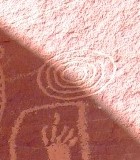 |
ArchaeoastronomyEquinox Observations at Atlatl RockValley of Fire State Park, NV, USA |
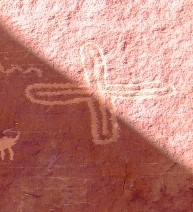 |
Analysis of all Observations and Results
Definition of TermsDate / Time / Clock Nevada: Pacific Daylight saving Time (PDT) = UT - 7h; (daylight saving time in effect from mid March to begin of November) |T10| For dates and alike, especially in tables, I use the format: yyyy-mm-dd-hh:mm (24-hour clock for UT or 12-hour clock for PDT); within text the date is written: month day , year. Due to the Local noon (Sun due south from Atlatl Rock) in March/April:time to/from astronomical equinox: E ± fraction of days (e.g. E - 1.44 is 1 day and 10 hours and 34 minutes before equinox) Correction of the Clock Drift of the Camera The time of my camera always had been set to UT. Like almost each clock, this If times quoted have been corrected, they are marked with "tc". Horizontal Coordinate System For the position of the Sun the - the azimuth (Az) of the Sun is the angle in degrees from North; measured N -> E -> S -> W - the elevation (El) is the height of the Sun in degrees above the horizon Picture PointsAll the pictures taken to document the movement of the shadow line across the petroglyps at Atlatl Rock in 2015, 2017, and 2018 were always made from the same location on the stairs to the platform, the standard picture point for the markers.The point on the stairs from where the pictures were taken was choosen in such a way that the cross was directly visible above one of the struts of the platform to check the proper position. The pictures taken to document the sunrise location on the eastern horizon were always made from the same point on the platform, the sunrise picture point. This point is directly at the strut that marks the proper alignment of the view to the markers. Equinoxes and Solar Quarter DaysTheThe astronomical equinoxes are not directly observable by the naked eye nor could the equal lenght of day and night (= equinox) be determined with sufficient accuracy by the sunwatchers of ancient times. However, the astronomical equinoxes are close to the middle (in days) between the summer and winter solstices. (The solstices, different to the equinoxes, could be determined with an accuracy of about one day by ancient sunwatchers and were determined and observed in almost all cultures.) The middle between the solstices can be determined by counting the days from a solstice. These "middle" days are sometimes called quarter days as together with the solstices they divide a year into four quarters of equal length. I prefer to call them solar quarter days as not to confuse them with the quarter days used in England and Ireland which have a different definition. Due to the variable speed of the Earth in its elliptical orbit around the Sun, which is a little bit faster in winter, the astronomical equinoxes are off by about two days from the solar quarter days. The solar quarter day in spring is two days after the astronomical vernal equinox, the solar quarter day in fall is two days before the astronomical autumnal equinox. Throughout this web pages I use the term "equinox" for a time span of a couple of days around the astronomical equinox including the solar quarter days. The MarkersAt the Atlatl Rock site there are three outstanding petroglyphs which are proposed to indicate the time around the equinoxes by showing some "interaction" with a shadow edge in the hours before and around local noon. They belong to a group of petroglyps which, among other pictures, show an atlatl, giving the rock its name.The proposed "equinox" markers are four concentric circles (known to be a sun marker), an outlined cross and a (left?) "foot". As it finally turned out, this foot has the very important function to signal the "equinox" (or solar quarter day) when the primary shadow touches its upper part the first time (in spring) or the last time (in fall). All petroglyps (exept the "foot") are to the left of an imaginary line tangent to the upper edge of the concentric circles and the outlinded cross. 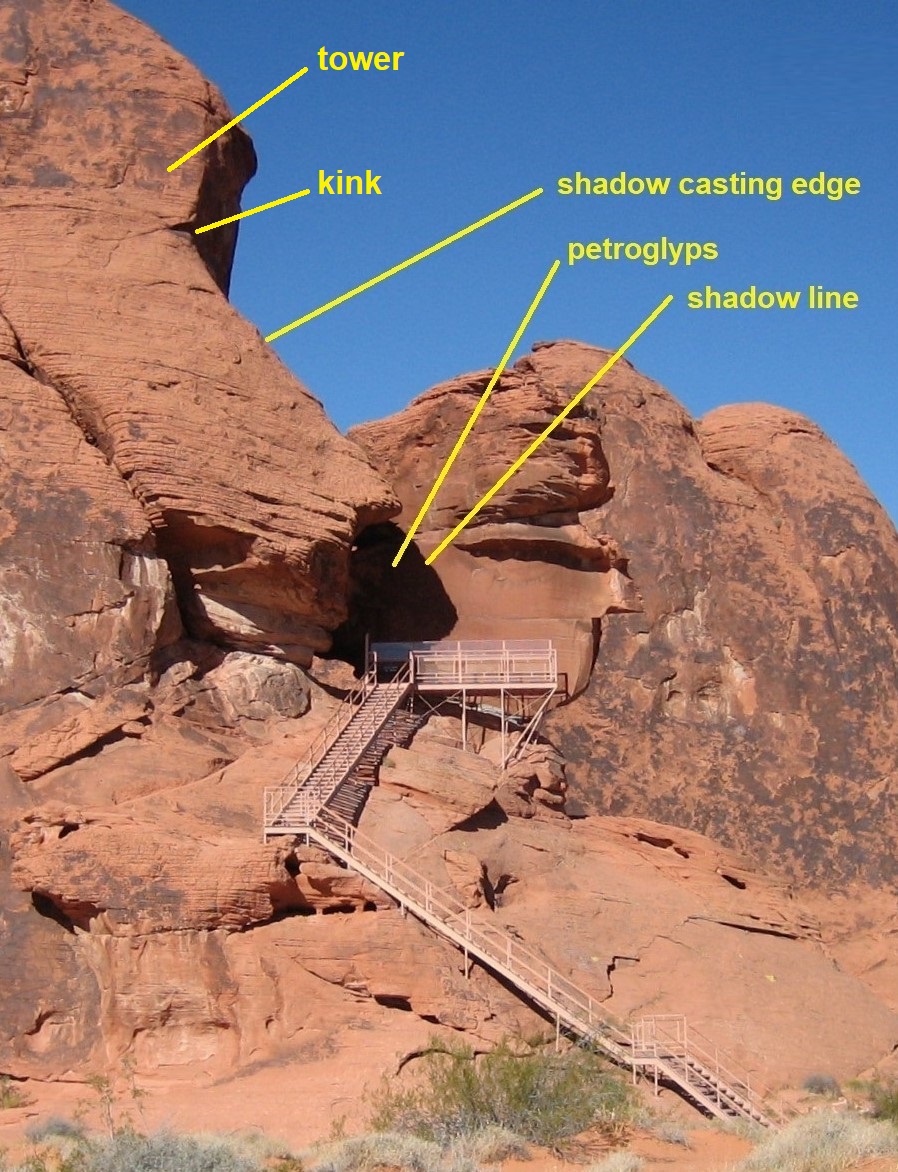
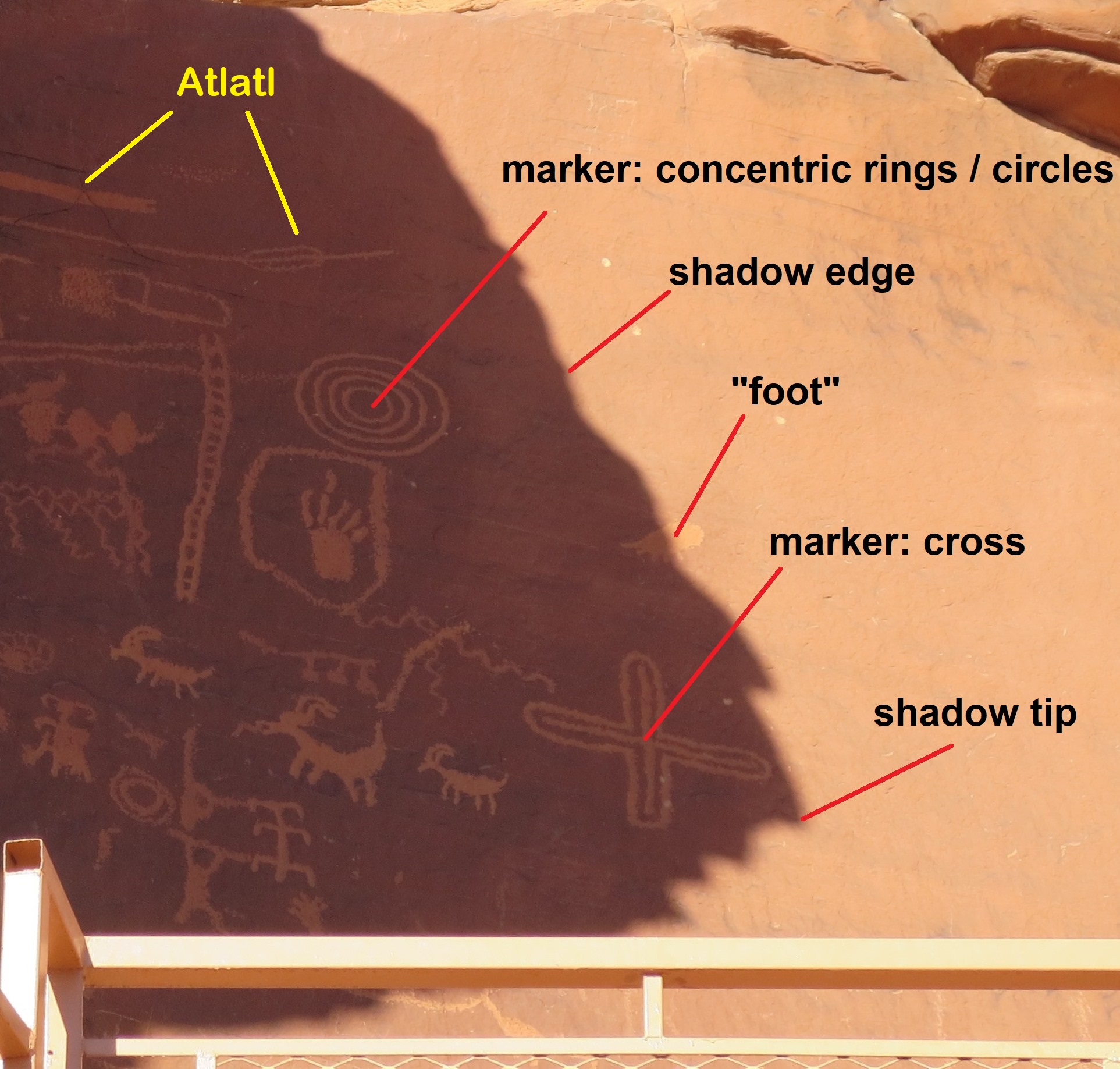
The alignment and the dimensions of the concentric circles and the embedded cross are such that they are parallel to the shadow edge. The shadow is tangent to the upper edges of the two markers at the same time. This is true also for the centers and the lower edges of the markers. Primary and Secondary Shadow MovementThe rock south of the Atlatl Rock wall that casts the shadow onto the wall where the petroglyps with the atlatl are has an almost straight upper edge which casts a shadow with an straight upper edge onto the wall.There are two reasons that cause the movement of this shadow edge across the Atlatl Rock wall during the year and during a day: - the primary shadow movement between following days is caused by the change in elevation of the Sun. On each day, between 9:30 am PDT and 10:50 am PDT, the fully developed shadow edge is very stable and only wiggles a little bit. - the secondary shadow movement during one day is caused by a combination of the changing azimuth and elevation of the Sun and the effect of the change of the slope of the shadow casting rock which comes into effect after ~ 10:50 am PDT and before the rock is in self shadow after ~ 12:15 pm PDT. A complete movement of the shadow from sunrise until the rock is in self shadow is shown in a movie of the September 17, 2017 data. Primary Shadow Movement : The decreasing elevation of the Sun after the summer solstice causes the upper shadow edge at Atlatl Rock to move upward between each following day. In the first couple of weeks after solstice the change in elevation is small. Around equinox however the change in shadow position has a maximum of about 0.36 deg each day and this causes the upper shadow edge around the autumnal equinox to move upward significantly between following days. This is best shown in a movie that shows the shadow position for each of the nine days before astronomical autumnal equinox at the same time at ~ 10:45 am PDT. In the time span between 9:30 am PDT and 10:50 am PDT each day the shadow edge is very straight and almost constant in position and thus 10:45 am PDT is a good reference point in time for the description of the behaviour of the shadow edge before the downward movement of the shadow starts. Secondary Shadow Movement: (each day after 10:50 am PDT until the rock is in self shadow around 12:15 pm PDT) After the shadow tip has moved beyond the markers at about 9:30 am PDT and before about 10:50 am PDT the daily apparent movement of the rising Sun across the sky is almost parallel to the edge on the rock that casts the shadow on the petroglyphs. During this time span the shadow edge wiggles around and at the end of this time span it becomes an almost constant straight line.
Atlatl Rock from north-northeast
Atlatl Rock from south
shadow casting rock as seen from the platform near the markers After about 10:50 am PDT, during the movement of the Sun over the sky, the tilt of the rock edge that causes the shadow changes and it becomes flatter by some degrees. As the Sun continues to rise towards the highest position at local noon, the shadow edge, that is still straight and parallel to the centers of the markers, starts to move downward until the wall is in self shadow ~ 12:15 pm PDT. The observations from each of the nine days before astronomical autumnal equinox show that around 10:50 am PDT the shadow edge starts to move down from beeing above the markers. This is shown here on the pictures taken on 13 September 2018:
Self ShadowOne special feature of the wall with the petroglyps at Atlatl Rock is that once the azimuth of the Sun is larger than ~ 174 degrees, which is at about 12:15 pm PDT in September or about 15 minutes before local noon, the wall is in total shadow as the Sun is then "behind" the plane of the wall.This I call "self shadow" to distinguish it from the shadow cast by the rock south of the wall that produces the shadow whose upper edge is the shadow line that at certain moments passes through the centers of the markers. After local noon the whole area is in shadow cast by the "tower" and the whole Atlatl Rock massiv. Analysis of 2008 "Observation" - The Discovery.jpg) Observation made on September 12, 2008 at 11:30 am PDT.
Observation made on September 12, 2008 at 11:30 am PDT.
Daylight saving time 2008 in Nevada started March 9 and ended November 2. |T13| Astronomical autumnal equinox: 2008-09-22-15:44 UT = 2008-09-22-08:44 PDT (Nevada) |T12| (Only two) pictures taken: 2008-09-12-11:30 am PDT (18:30 UT; view from parking lot), Sun azimuth 151.83 deg (i.e. east of meridian) , Sun elevation 54.21 deg 2008-09-12-11:32 am PDT (18:32 UT; at the petroglyps); see right Sun azimuth 152.63 deg (i.e. east of meridian) , Sun elevation 54.40 deg distance from equinox: 9.84 days before astronomical autumnal equinox 8 days before autumnal solar quarter day With the knowledge after the 2018 observations it is clear that the pictures were taken few minutes after the shadow line crossed the centers of the markers on its way downward to beyond the markers during the secondary shadow movement. This is about 45 minutes before the wall with the petroglyps is in total shadow (c.f. the almost identical shadow position on September 13, 2018 at 11:31 am PDT). Analysis of the 2010 ObservationsObservations made on September 21, 2010 from sunrise until the petroglyphs were all in self shadow.Daylight saving time 2010 in Nevada started March 14 and ended November 7. |T13| Astronomical autumnal equinox: 2010-09-22-20:09 pm PDT; JD 2455462.63137 |T12| The picture shown below was the last one taken with a well defined shadow edge before the whole rock was in self shadow (which was 6 minutes later at about 12:12 pm PDT). The movie combines all pictures of the markers made on that day.
Analysis of the Combined 2017 and 2018 Observations Around Autumnal EquinoxThe observations that contribute to the analysis described here were all made between September 13 and 21 (2018 and 2017).Note: all descriptions that have not been "observed" but can be derived from the observations are printed in italics. Astronomical autumnal equinox was on September 22, 2017 at 01:02 pm PDT and on September 22, 2018 at 06:54 pm PDT. Autumnal solar quarter day was on September 20, 2017 (at 3:26 pm PDT) and on September 20, 2018 (at 9:14 pm PDT). Detailed Descripton of the Observations Made on the Nine Days Before Autumnal Equinox By combining the 2018 and 2017 observations, the time span nine days before the autumnal equinox up to one day before the autumnal equinox is covered. On each of the nine days pictures have been taken every 15 minutes after 10:15 am PDT until the shadow edge was no longer well defined as the wall started to be in self shadow around 12:15 pm PDT. They have been combined into movies - for each single day (SDxx; September 13 to 21)showing the secondary shadow movement each day and - for the same time (STxxxx; 10:15 am PDT in steps of 15 minutes to 12:15 pm PDT) which show the primary shadow movement between following days. The numbers in the following matrix are picture (image) numbers (per year) and in parentheses the time (in minutes) to be added to the time in the left column to calculate the time the picture was taken. Although I aimed to take the pictures always at the same time intervall, sometimes I missed that by few minutes (larger deviations in red).
Primary Shadow Movement This is best shown "same time" (ST) movies in the table above in the right column that show the shadow position for each of the nine days before astronomical autumnal equinox at the same time. In the time span between 9:30 am PDT and 10:50 am PDT each day the shadow edge is very straight and almost constant in position and thus is a good reference point in time for the description of the behaviour of the shadow edge before the downward movement of the shadow starts. From the observations in 2018 and 2017 it can be derived, that the movement of the shadow edge between following days is about one eighth the diameter of the concentric circles marker (or about one gap between the circles per day!). From this observations it can be estimated that the date in fall when the shadow edge for the first time reaches the circles and cross markers from below is about 18 days before astronomical autumnal eqinox (~ September 4th ). Then, about 14 days before astronomical autumnal eqinox (~ September 8th), the shadow edge connects the centers of the markers for the first time since the spring eqinox. Finally, about 10 days before astronomical autumnal eqinox (~ September 12th ) is about the date when the shadow reaches the upper edge of the two markers. About seven days before astronomical autumnal eqinox (~ September 15th ), the shadow edge for the first time touches the "foot" and moves over it the following five days until two days before astronomical autumnal eqinox. This is the autumnal solar quarter day and from now on all petroglyphs at Atlatl Rock are in shadow until vernal equinox. The following pictures have been taken at about 10:45 am PDT on the days before autumnal equinox. Comparison of the Observations at ~10:45 am and ~11.00 am PDT ten (9.35) days to one (1.11) day before Autumnal Equinox Secondary Shadow Movement: (after 10:50 am PDT each day) This is best shown in the "same day" (SD) movies in the table above in the last two rows that show the shadow position for each of the nine days before astronomical autumnal equinox between 9:45 am PDT and 12:15 pm PDT. At this time during the movement of the Sun over the sky the tilt of the rock edge that causes the shadow changes and becomes flatter by some degrees. As the Sun continues to rise, the shadow edge, that is now very straight and parallel to the centers of the markers, starts to move downward until the wall is in self shadow shortly after ~ 12:15 pm PDT. As the timespan until the rock is in self shadow is almost fixed (10:50 am PDT to 12:15 pm PDT) the distance the shadow edge moves down is also fixed and it (thus) moves each following day less far down over the markers before the wall is in self shadow. It does not reach the the markers anymore after September 18th (see movie from September 18, 2017), which is four days before astronomical autumnal equinox (or two days before autumnal solar quarter day). Compare also the two extreme movies from September 13 and September 21! The movie from September 13 also shows, that the distance covered by the downward movement in the timespan 10:50 am PDT to 12:15 pm PDT is almost exactly the height of the markers (concentric circles and the cross). The last pictures taken at about 12:15 pm PDT on each of the nine observed days before astronomical autumnal equinox have been combined into a movie to show what happens there. Unfortunately not all pictures have been taken at the same time each day and also not frequently enough and thus they can only give a hint what can be observed in the last minute(s) before the wall is in self shadow. During its downward movement due to the secondary shadow movement the shadow edge "dances" across the markers because the movement of the shadow edge is now not strictly in one direction and it moves up and down a little bit several times. This starts September 4th when the shadow edge due to the primary shadow movement reaches the markers the first time in fall. It ends on September 18th when the downward moving shadow starts from such a high position above the markers that it just touches the markers the last time from above before the wall is in shadow (see movie). A special moment during those days when the shadow edge moves downward across the markers is, when it passes simultaneously right through the centers of the markers. The first time in fall that this happens during the secondary shadow movement is after September 8th. Then, on its movement down, the shadow edge again connects the centers of the markers. As it "dances" up an down during this time span, it crosses the centers several times. The last time the shadow line passes simultaneously through the centers of the two markers before the wall is in shadow occurs on September 17th (see movie), five days prior to the astronomical autumnal equinox (three days before the autumnal solar quarter day). Final conclusion concerning the shadow movements: All the detailed observations of the secondary shadow movement lead to the conclusion, that the interplay of the shadow edge and the markers is too vague and too uncertain to establish a clear signature. It therefore has been decided to only consider the primary shadow movement to have a clear connetion to the solar quarter days and the equinoxes.
Sunrise ObservationsThe location of the sunrise around autumnal equinox at the flat horizon has been determined on eight days (in different years) with different distances (in time) to the astronomical autumnal eqinox date. Here also the sunrise observations made in 2015 are used.The pictures taken to document the sunrise location on the eastern horizon were always made from the same point on the platform, the sunrise picture point. The azimuth of the point at the horizon where the Sun is visible the first time at sunrise changes significantly by about 0.5 deg per day around the days of the equinoxes (this is almost exactly the apparent diameter of the Sun and also the Moon). This makes the observation of the sunrise a very good and exact tool to mark certain dates if structures on the horizon or alignments with structures in that direction are available.
(Sunrise near summer solstice has been observed only once three days after solstice on June 24, 2011.) A summary of the autumnal (fall) equinox observations is this picture with the distances to the astronomical equinox in days indicated (negative is before): Depending on the location from where the sunrise is observed, the rocks in the foreground (at a distance of about 280 meters) may be used to indicate the location of the sunrise at a desired date. Timetable of Observed Events(primary shadow interactions only)The following is a timetable of the interaction of the shadow with the markers to be observed each year in relation to the astronomical equinox and the solar quarter days. Observations have been made on the dates marked in light red. The dates are good ± 1 day. Any verification of the dates of the events that have not been observed and documented so far would be extremely welcome! |
|||||||||||||||||||||||||||||||||||||||||||||||||||||||||||||||||||||||||||||||||||||||||||||||||||||||||||||||||||||||||||||||||||||||||||||||||||||||||||||||||||||||||||||||||||||||||||||||||||||||||||||||||||||||||||||||||||||||||||||||||||||||||||||||||||||||||||||||||||||||
by Helmut Steinle
